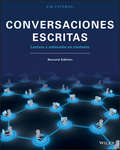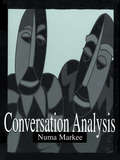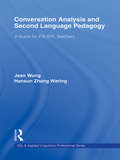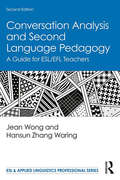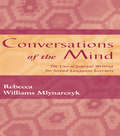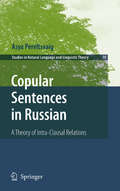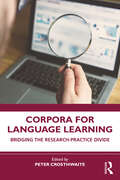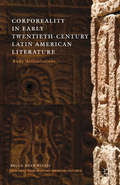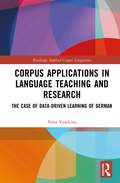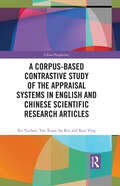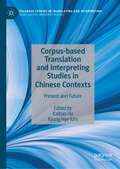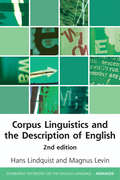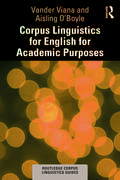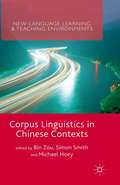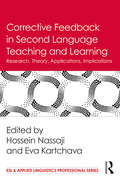- Table View
- List View
Conversaciones escritas: Lectura y redacción en contexto
by Kim PotowskiConversaciones escritas: Lectura y redaccion en contexto, 2nd Edition contains updated data and resources including substantial revisions throughout the book as well as translated texts that have been re-edited for structure and fluency. This text includes more suggested video links in Spanish and writing activities based on essays to help readers write in Spanish. Each chapter contains a minimum of two readings, each presenting different aspects of a particular debate on topics. With the help of engaging essays and practice exercises that more closely reflect thematic content of chapters; the heart of this text deals with contemporary cultural and community topics.
Conversation Analysis (Second Language Acquisition Research Series)
by Numa MarkeeConversation analysis is a methodology that originated over three decades ago as a sociolinguistic approach but has since been adopted by scholars in a variety of other areas, including applied linguistics and communication. It is of great utility in second language acquisition research for its demonstrations of how micro-moments of socially distributed cognition instantiated in conversational behavior contribute to observable changes in the participants' states of knowing and using a new language. This volume describes the methodology in detail, discusses its relevance for current theories of SLA, and uses two extended examples of conversational analysis to show how learners succeed or fail at the job of learning the meaning of a word or phrase in conversational context. This book is one of several in LEA's Second Language Acquisition Research Series dealing with specific data collection methods or instruments. Each of these monographs addresses the kinds of research questions for which the method/instrument is best suited, its underlying assumptions, a characterization of the method/instrument and extended description of its use and problems associated with its use. For more information about these volumes, please visit LEA's Web site at www.erlbaum.com
Conversation Analysis: Capturing Transitions In The Classroom (Second Language Acquisition Research Series #295)
by Numa MarkeeConversation analysis is a methodology that originated over three decades ago as a sociolinguistic approach but has since been adopted by scholars in a variety of other areas, including applied linguistics and communication. It is of great utility in second language acquisition research for its demonstrations of how micro-moments of socially distributed cognition instantiated in conversational behavior contribute to observable changes in the participants' states of knowing and using a new language. This volume describes the methodology in detail, discusses its relevance for current theories of SLA, and uses two extended examples of conversational analysis to show how learners succeed or fail at the job of learning the meaning of a word or phrase in conversational context. This book is one of several in LEA's Second Language Acquisition Research Series dealing with specific data collection methods or instruments. Each of these monographs addresses the kinds of research questions for which the method/instrument is best suited, its underlying assumptions, a characterization of the method/instrument and extended description of its use and problems associated with its use. For more information about these volumes, please visit LEA's Web site at www.erlbaum.com
Conversation Analysis and Second Language Pedagogy: A Guide for ESL/ EFL Teachers (ESL & Applied Linguistics Professional Series)
by Jean Wong Hansun Zhang WaringConversation and speaking skills are the key building blocks for much of language learning. This text increases teachers’ awareness about spoken language and suggests ways of applying that knowledge to teaching second-language interaction skills based on insights from Conversation Analysis (CA). Conversation Analysis and Second Language Pedagogy: reviews key CA concepts and findings directly connects findings from CA with second language pedagogy presents a model of interactional practices grounded in CA concepts includes numerous transcripts of actual talk invites readers to complete a variety of tasks to solidify and extend their understandings features a useful collection of practical teaching activities. The time is ripe for a book that blends conversation analysis and applied linguistics. This text takes that important step, extending the reaches of these once separate academic fields. Assuming neither background knowledge of conversation analysis nor its connection to second language teaching, it is designed for courses in TESOL and applied linguistics and as a resource for experienced teachers, material developers, and language assessment specialists seeking to update their knowledge and hone their craft.
Conversation Analysis and Second Language Pedagogy: A Guide for ESL/ EFL Teachers (ESL & Applied Linguistics Professional Series)
by Jean Wong Hansun Zhang WaringConversation and speaking skills are the key building blocks for much of language learning. This text increases teachers’ awareness about spoken language and suggests ways of applying that knowledge to teaching second-language interaction skills based on insights from Conversation Analysis (CA). Conversation Analysis and Second Language Pedagogy: reviews key CA concepts and findings directly connects findings from CA with second language pedagogy presents a model of interactional practices grounded in CA concepts includes numerous transcripts of actual talk invites readers to complete a variety of tasks to solidify and extend their understandings features a useful collection of practical teaching activities. The time is ripe for a book that blends conversation analysis and applied linguistics. This text takes that important step, extending the reaches of these once separate academic fields. Assuming neither background knowledge of conversation analysis nor its connection to second language teaching, it is designed for courses in TESOL and applied linguistics and as a resource for experienced teachers, material developers, and language assessment specialists seeking to update their knowledge and hone their craft.
Conversation Analysis and Second Language Pedagogy: A Guide for ESL/EFL Teachers (ESL & Applied Linguistics Professional Series)
by Jean Wong Hansun Zhang WaringNow in its second edition, this volume offers a strong synthesis of classic and current work in conversation analysis (CA), usefully encapsulated in a model of interactional practices that comprise interactional competence. Through this synthesis, Wong and Waring demonstrate how CA findings can help to increase language teachers’ awareness of the spoken language and suggest ways of applying that knowledge to teaching second language interaction skills. The Second Edition features: Substantial updates that include new findings on interactional practices Reconceptualized, reorganized, and revised content for greater accuracy, clarity, and readability Expanded key concepts glossary at the end of each chapter New tasks with more transcripts of actual talk New authors' stories The book is geared towards current and prospective second or foreign language teachers, material developers, and other language professionals, and assumes neither background knowledge of conversation analysis nor its connection to second language teaching. It also serves as a handy reference for those interested in key CA findings on social interaction.
Conversation Analysis and Second Language Pedagogy: A Guide for ESL/EFL Teachers (ESL & Applied Linguistics Professional Series)
by Jean Wong Hansun Zhang WaringNow in its second edition, this volume offers a strong synthesis of classic and current work in conversation analysis (CA), usefully encapsulated in a model of interactional practices that comprise interactional competence. Through this synthesis, Wong and Waring demonstrate how CA findings can help to increase language teachers’ awareness of the spoken language and suggest ways of applying that knowledge to teaching second language interaction skills. The Second Edition features: Substantial updates that include new findings on interactional practices Reconceptualized, reorganized, and revised content for greater accuracy, clarity, and readability Expanded key concepts glossary at the end of each chapter New tasks with more transcripts of actual talk New authors' stories The book is geared towards current and prospective second or foreign language teachers, material developers, and other language professionals, and assumes neither background knowledge of conversation analysis nor its connection to second language teaching. It also serves as a handy reference for those interested in key CA findings on social interaction.
Conversations of the Mind: The Uses of Journal Writing for Second-Language Learners
by Rebecca William MlynarczykAsking students to write journals that reflect on their learning has become a widespread pedagogical practice in recent years. However, the scholarly literature does not address certain key questions about how journal writing aids learning: * Is there something inherent in journal writing that encourages students to write reflectively? * What psycholinguistic or cognitive factors help to explain the power of journal writing? * Why do some students use journals to write prolifically and creatively while others limit their responses to summarizing the assigned course reading? * Why do teachers find some journal entries so much more engaging than others? * How do teachers' ways of responding to journals affect their students' development as writers and thinkers? This book addresses such questions through a careful analysis of the journal writing of the students in the author's ESL classes at a large urban college. It contains detailed case studies of five culturally- and linguistically-diverse students with widely differing responses to journal writing. To teachers of composition for both first- and second-language students and to teachers of graduate courses in education and qualitative research, this book offers a contextualized description of journal writings as a complex social activity. By emphasizing the need for educators to reexamine their pedagogy and to learn from their students, Conversations of the Mind is an indispensable contribution to the emerging literature of teacher research and reflective practice.
Conversations of the Mind: The Uses of Journal Writing for Second-Language Learners
by Rebecca William MlynarczykAsking students to write journals that reflect on their learning has become a widespread pedagogical practice in recent years. However, the scholarly literature does not address certain key questions about how journal writing aids learning: * Is there something inherent in journal writing that encourages students to write reflectively? * What psycholinguistic or cognitive factors help to explain the power of journal writing? * Why do some students use journals to write prolifically and creatively while others limit their responses to summarizing the assigned course reading? * Why do teachers find some journal entries so much more engaging than others? * How do teachers' ways of responding to journals affect their students' development as writers and thinkers? This book addresses such questions through a careful analysis of the journal writing of the students in the author's ESL classes at a large urban college. It contains detailed case studies of five culturally- and linguistically-diverse students with widely differing responses to journal writing. To teachers of composition for both first- and second-language students and to teachers of graduate courses in education and qualitative research, this book offers a contextualized description of journal writings as a complex social activity. By emphasizing the need for educators to reexamine their pedagogy and to learn from their students, Conversations of the Mind is an indispensable contribution to the emerging literature of teacher research and reflective practice.
Copular Sentences in Russian: A Theory of Intra-Clausal Relations (Studies in Natural Language and Linguistic Theory #70)
by Asya PereltsvaigThis book provides a detailed study and a novel Minimalist account of copular sentences in Russian, focusing on case marking alternations (nominative vs. instrumental) and drawing a distinction between two types of copular sentences. On the assumption that Merge is defined in the simplest way possible, it is argued that not all syntactic structures are a(nti)symmetrical. One of the copular sentence types is analyzed as a poster child for symmetrical structures, while the other type is treated as asymmetrical. The originality of this study lies in treating the copula in the two types of copular sentences neither as completely identical nor as two distinct lexical items; instead, the two types of copula are derived through the process of semantic bleaching. Furthermore, it is argued that the two types of the copula need to combine with post-copular phrases of different categories. It is concluded that Russian draws a distinction between saturated DPs and unsaturated NPs, in spite of its renowned lack of overt articles.
Corpora for Language Learning: Bridging the Research-Practice Divide
by Peter CrosthwaiteThis volume presents a diverse range of expertise and practical advice on corpus-assisted language learning, bridging the gap between corpus research and actual classroom practice.Grounded in expert discussions and interviews, the book offers an extensive exploration into the intricacies of corpus-based language pedagogy, addressing its challenges, benefits, and potential drawbacks while demonstrating the power of data-driven learning (DDL) tools, including AntConc, WordSmith Tools, and CorpusMate. The book navigates the complexities of integrating DDL into mainstream educational systems, showcasing real-world applications for teaching. The authors bring together cutting-edge, international perspectives on this topic in dialogue with those using such techniques in their classroom practice.Both a rigorous academic resource and a hands-on guide for practitioners, this book is recommended reading for educators, researchers, or anyone wanting to upskill themselves in learning to harness the power of data in language pedagogy in primary, secondary, tertiary, or other professional contexts.
Corpora for Language Learning: Bridging the Research-Practice Divide
This volume presents a diverse range of expertise and practical advice on corpus-assisted language learning, bridging the gap between corpus research and actual classroom practice.Grounded in expert discussions and interviews, the book offers an extensive exploration into the intricacies of corpus-based language pedagogy, addressing its challenges, benefits, and potential drawbacks while demonstrating the power of data-driven learning (DDL) tools, including AntConc, WordSmith Tools, and CorpusMate. The book navigates the complexities of integrating DDL into mainstream educational systems, showcasing real-world applications for teaching. The authors bring together cutting-edge, international perspectives on this topic in dialogue with those using such techniques in their classroom practice.Both a rigorous academic resource and a hands-on guide for practitioners, this book is recommended reading for educators, researchers, or anyone wanting to upskill themselves in learning to harness the power of data in language pedagogy in primary, secondary, tertiary, or other professional contexts.
Corporeality in Early Twentieth-Century Latin American Literature: Body Articulations (New Directions in Latino American Cultures)
by B. WillisFeaturing canonical Spanish American and Brazilian texts of the 1920s and 30s, Corporeality in Early Twentieth-Century Latin American Literature is an innovative analysis of the body as site of inscription for avant-garde objectives such as originality, subjectivity, and subversion.
Corpus Applications in Language Teaching and Research: The Case of Data-Driven Learning of German (Routledge Applied Corpus Linguistics)
by Nina VyatkinaCorpus Applications in Language Teaching and Research: The Case of Data-Driven Learning of German provides a historical overview of corpus applications in language teaching with a focus on German. The book identifies challenges in using corpus applications and data-driven learning (DDL) research for Languages Other Than English (LOTEs) and addresses these challenges through various approaches. Overall, this book: surveys corpus applications for teaching and learning German, highlighting the growth of the L2 German DDL field and identifying trends in integrating DDL into pedagogical practice; presents empirical research on the effectiveness of DDL applications for teaching and learning German in comparison with research on English and other LOTEs, emphasizing the need for expanding the scope of DDL research to include more languages, skills, and study types; compares teaching interventions for L2 collocations in the fields of Instructed Second Language Acquisition (ISLA) and DDL, highlighting methodological differences between the two paradigms and proposing a combined ISLA/DDL framework to bridge the disconnect; showcases a successful DDL intervention that resulted in significant learning gains in German collocation knowledge, filling a gap in DDL research; proposes an Open Educational Resource (OER) for teaching and learning German, incorporating open access corpora, learner-fit criteria, new tools and technology, and usage-based learning principles; examines the current difficulties encountered by the DDL field and highlights potential directions for future research and pedagogical approaches. This book offers insights and resources for researchers, language teaching practitioners, and students interested in corpus-based learning and teaching methods. While the focus is on teaching German to English-speaking students, the book's findings have broader applicability to language teaching and learning in different contexts.
Corpus Applications in Language Teaching and Research: The Case of Data-Driven Learning of German (Routledge Applied Corpus Linguistics)
by Nina VyatkinaCorpus Applications in Language Teaching and Research: The Case of Data-Driven Learning of German provides a historical overview of corpus applications in language teaching with a focus on German. The book identifies challenges in using corpus applications and data-driven learning (DDL) research for Languages Other Than English (LOTEs) and addresses these challenges through various approaches. Overall, this book: surveys corpus applications for teaching and learning German, highlighting the growth of the L2 German DDL field and identifying trends in integrating DDL into pedagogical practice; presents empirical research on the effectiveness of DDL applications for teaching and learning German in comparison with research on English and other LOTEs, emphasizing the need for expanding the scope of DDL research to include more languages, skills, and study types; compares teaching interventions for L2 collocations in the fields of Instructed Second Language Acquisition (ISLA) and DDL, highlighting methodological differences between the two paradigms and proposing a combined ISLA/DDL framework to bridge the disconnect; showcases a successful DDL intervention that resulted in significant learning gains in German collocation knowledge, filling a gap in DDL research; proposes an Open Educational Resource (OER) for teaching and learning German, incorporating open access corpora, learner-fit criteria, new tools and technology, and usage-based learning principles; examines the current difficulties encountered by the DDL field and highlights potential directions for future research and pedagogical approaches. This book offers insights and resources for researchers, language teaching practitioners, and students interested in corpus-based learning and teaching methods. While the focus is on teaching German to English-speaking students, the book's findings have broader applicability to language teaching and learning in different contexts.
A Corpus-based Contrastive Study of the Appraisal Systems in English and Chinese Scientific Research Articles (China Perspectives)
by Xu Yuchen Yan Xuan Su Rui Kou YingAppraisal is the way language users express their attitude towards things, people, behaviour or ideas. In the last few decades, significant achievements have been made in Appraisal Theory research, yet little attention has been paid to appraisal in scientific texts, especially in relation to the contrast to how it is applied in English and Chinese. This title examines the similarities and differences of Appraisal systems in English and Chinese scientific research articles. Using a self-constructed corpus of scientific research articles, the authors make cross-linguistic comparisons in terms of the quantity and distribution patterns of categories of appraisals. They creatively categorise articles into theoretical scientific research articles and applied studies and discover that for both languages, each genre can have its own favorite mode of distribution for the realization of appraisal systems. In addition, this research helps appraisal theory systems to become more explicit, specific, and more applicable for the analysis of scientific research articles. Students and scholars of applied linguistics, comparative linguistics and corpus linguistics will find this an essential reference.
A Corpus-based Contrastive Study of the Appraisal Systems in English and Chinese Scientific Research Articles (China Perspectives)
by Xu Yuchen Yan Xuan Su Rui Kou YingAppraisal is the way language users express their attitude towards things, people, behaviour or ideas. In the last few decades, significant achievements have been made in Appraisal Theory research, yet little attention has been paid to appraisal in scientific texts, especially in relation to the contrast to how it is applied in English and Chinese. This title examines the similarities and differences of Appraisal systems in English and Chinese scientific research articles. Using a self-constructed corpus of scientific research articles, the authors make cross-linguistic comparisons in terms of the quantity and distribution patterns of categories of appraisals. They creatively categorise articles into theoretical scientific research articles and applied studies and discover that for both languages, each genre can have its own favorite mode of distribution for the realization of appraisal systems. In addition, this research helps appraisal theory systems to become more explicit, specific, and more applicable for the analysis of scientific research articles. Students and scholars of applied linguistics, comparative linguistics and corpus linguistics will find this an essential reference.
Corpus-based Translation and Interpreting Studies in Chinese Contexts: Present and Future (Palgrave Studies in Translating and Interpreting)
by Kaibao Hu Kyung Hye KimThis edited collection reflects on the development of Chinese corpus-based translation and interpreting studies while emphasising perspectives emerging from a region that has traditionally been given scant consideration in English-language dominated literature. Striking the balance between methodological and theoretical discussion on corpus-based empirical research into Chinese translation and interpreting studies, the chapters additionally introduce and examine a wide variety of case studies. The authors include up-to-date corpus-based research, and place emphasis on new perspectives such as sociology-informed approaches and cognitive translation studies. The book will be of interest to researchers and advanced students of translation/interpreting and contrastive linguistics studies, corpus linguistics, and Chinese linguistics.
Corpus Linguistics and the Description of English
by Hans Lindquist Magnus LevinWartime British writers took to the airwaves to reshape the nation and the Empire
Corpus Linguistics and the Description of English (Edinburgh Textbooks On The English Language - Advanced Ser.)
by Hans Lindquist Magnus LevinExamines the social functions of attitude dative pronouns in four Arabic dialects
Corpus Linguistics for English for Academic Purposes (Routledge Corpus Linguistics Guides)
by Vander Viana Aisling O'BoyleThis book shows how corpus analyses can enhance students’, practitioners’ and researchers’ knowledge of academic language. The book provides a reader-friendly discussion of the key concepts, practices and research applications of corpus linguistics which are relevant to the EAP community. The volume: • empowers readers to compile and analyze EAP-relevant corpora to support their practice; • draws on open-access resources, allowing readers in all contexts to engage in corpus analyses; • examines how corpus studies have advanced the description of spoken, written and computer-mediated academic discourses; • contains numerous reflective and hands-on tasks. Corpus Linguistics for English for Academic Purposes is an essential book for EAP students, practitioners and researchers who wish to develop corpus analytical skills to support their learning, teaching and research practice. It is equally important to novice corpus linguists who wish to find out how they can contribute to the ever-expanding area of EAP.
Corpus Linguistics for English for Academic Purposes (Routledge Corpus Linguistics Guides)
by Vander Viana Aisling O'BoyleThis book shows how corpus analyses can enhance students’, practitioners’ and researchers’ knowledge of academic language. The book provides a reader-friendly discussion of the key concepts, practices and research applications of corpus linguistics which are relevant to the EAP community. The volume: • empowers readers to compile and analyze EAP-relevant corpora to support their practice; • draws on open-access resources, allowing readers in all contexts to engage in corpus analyses; • examines how corpus studies have advanced the description of spoken, written and computer-mediated academic discourses; • contains numerous reflective and hands-on tasks. Corpus Linguistics for English for Academic Purposes is an essential book for EAP students, practitioners and researchers who wish to develop corpus analytical skills to support their learning, teaching and research practice. It is equally important to novice corpus linguists who wish to find out how they can contribute to the ever-expanding area of EAP.
Corpus Linguistics in Chinese Contexts (New Language Learning and Teaching Environments)
by Simon SmithRapid advances in computing have enabled the integration of corpora into language teaching and learning, yet in China corpus methods have not yet been widely adopted. Corpus Linguistics in Chinese Contexts aims to advance the state of the art in the use of corpora in applied linguistics and contribute to the expertise in corpus use in China.
Corrective Feedback in Second Language Teaching and Learning: Research, Theory, Applications, Implications (ESL & Applied Linguistics Professional Series #66)
by Hossein Nassaji Eva KartchavaBringing together current research, analysis, and discussion of the role of corrective feedback in second language teaching and learning, this volume bridges the gap between research and pedagogy by identifying principles of effective feedback strategies and how to use them successfully in classroom instruction. By synthesizing recent works on a range of related themes and topics in this area and integrating them into a single volume, it provides a valuable resource for researchers, graduate students, teachers, and teacher educators in various contexts who seek to enhance their skills and to further their understanding in this key area of second language education.
Corrective Feedback in Second Language Teaching and Learning: Research, Theory, Applications, Implications (ESL & Applied Linguistics Professional Series #66)
by Hossein Nassaji Eva KartchavaBringing together current research, analysis, and discussion of the role of corrective feedback in second language teaching and learning, this volume bridges the gap between research and pedagogy by identifying principles of effective feedback strategies and how to use them successfully in classroom instruction. By synthesizing recent works on a range of related themes and topics in this area and integrating them into a single volume, it provides a valuable resource for researchers, graduate students, teachers, and teacher educators in various contexts who seek to enhance their skills and to further their understanding in this key area of second language education.
